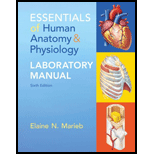
List the 11 organ systems of the body, briefly describe the function of each, and then name two organs in each system.
To review:
The 11 organ systems of the body along with their functions and names of two organs in each system.
Introduction:
An organ system comprises a group of organs that function together to perform a specific and common task or purpose. A total of eleven organ systems make up an organism or a living human being.
Explanation of Solution
The different organ systems are a skeletal system, integumentary system, cardiovascular system, nervous system, muscular system, lymphatic system, endocrine system, urinary system, digestive system, respiratory system, and reproductive system. The functions of the 11 organ systems listed above and the name of two organs in each system are described below:
Integumentary system: It is the outer covering of the body, that is, the skin including the fingernails and the hair. Its function is to protect and cushion the deeper body tissues from injury. It acts as a waterproof covering. It produces vitamin D with the help of sunlight. Skin and nerves are the two examples of organs of this system.
Skeletal system: It consists of cartilages, bones, and tendons. Its function is to provide framework and support to the body. It is protective in nature as it encloses and protects the brain. Bones and cartilages are two skeletal systems.
Muscular system: The muscular system is formed by the skeletal muscles. The muscles of the body contract or shorten and, thus, they help in the movement of body structures. Its organs are skeletal muscle tissues and blood vessels.
Cardiovascular system: This system delivers oxygen, nutrients, and hormones to the cells and picks up the waste material (carbon dioxide) from the cells. The blood is used as a carrier. The heart pumps blood into the blood vessels so that it can be transported to the different body tissues. The two organs in it are blood vessels and heart.
Nervous system: The functions of this system include a sensory system, interpretative function, and the motor function. The two organs of organ system are brain and spinal cord.
Lymphatic system: This system complements the function of cardiovascular system. This system removes interstitial fluid from the tissues, absorbs the fats and transports it from the digestive system, and transports the white blood cells (WBCs) from the lymph bones to the bone. Its organs are lymph nodes and lymphatic vessels.
Endocrine system: It controls and regulates the body activities. The endocrine system comprises different glands that secrete the chemicals known as hormones. Growth, use of nutrients, and reproduction are the major functions regulated by the endocrine system. The two main organs of the endocrine system are pancreas and thymus.
Respiratory system: Its function is to supply oxygen and remove carbon dioxide to the body. The two organs of this system are lungs and trachea.
Digestive system: Its function is to break down the food material into an absorbable form that can be taken up by intestine into the blood and, thus, it can be distributed to different body cells. The undigested food is eliminated from the body in the form of feces. The organs of this system are stomach, intestine, and esophagus.
Urinary system: Its function is to remove the liquid waste from the body in the form of urine. The two organs of this system are kidneys and urinary bladder.
Reproductive system: Its function is to produce the offspring. The two organs of this system are male reproductive organ testes producing sperm and female reproductive organ ovaries producing eggs.
The different organs work as a unit to form or build an organ system that performs a particular function in the body. The 11 organ systems form a living organism.
Want to see more full solutions like this?
Chapter 1 Solutions
Essentials of Human Anatomy & Physiology Laboratory Manual (6th Edition)
- Which of the following best describes why it is difficult to develop antiviral drugs? Explain why. A. antiviral drugs are very difficult to develop andhave no side effects B. viruses are difficult to target because they usethe host cell’s enzymes and ribosomes tometabolize and replicate C. viruses are too small to be targeted by drugs D. viral infections usually clear up on their ownwith no problemsarrow_forwardThis question has 3 parts (A, B, & C), and is under the subject of Nutrition. Thank you!arrow_forwardThey got this question wrong the 2 previous times I uploaded it here, please make sure it's correvct this time.arrow_forward
- This question has multiple parts (A, B & C), and under the subject of Nutrition. Thank you!arrow_forwardCalculate the CFU/ml of a urine sample if 138 E. coli colonies were counted on a Nutrient Agar Plate when0.5 mls were plated on the NA plate from a 10-9 dilution tube. You must highlight and express your answerin scientific notatioarrow_forwardDon't copy off the other answer if there is anyarrow_forward
 Medical Terminology for Health Professions, Spira...Health & NutritionISBN:9781305634350Author:Ann Ehrlich, Carol L. Schroeder, Laura Ehrlich, Katrina A. SchroederPublisher:Cengage Learning
Medical Terminology for Health Professions, Spira...Health & NutritionISBN:9781305634350Author:Ann Ehrlich, Carol L. Schroeder, Laura Ehrlich, Katrina A. SchroederPublisher:Cengage Learning Human Physiology: From Cells to Systems (MindTap ...BiologyISBN:9781285866932Author:Lauralee SherwoodPublisher:Cengage Learning
Human Physiology: From Cells to Systems (MindTap ...BiologyISBN:9781285866932Author:Lauralee SherwoodPublisher:Cengage Learning Human Biology (MindTap Course List)BiologyISBN:9781305112100Author:Cecie Starr, Beverly McMillanPublisher:Cengage Learning
Human Biology (MindTap Course List)BiologyISBN:9781305112100Author:Cecie Starr, Beverly McMillanPublisher:Cengage Learning





